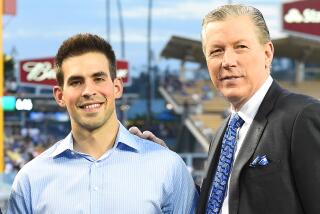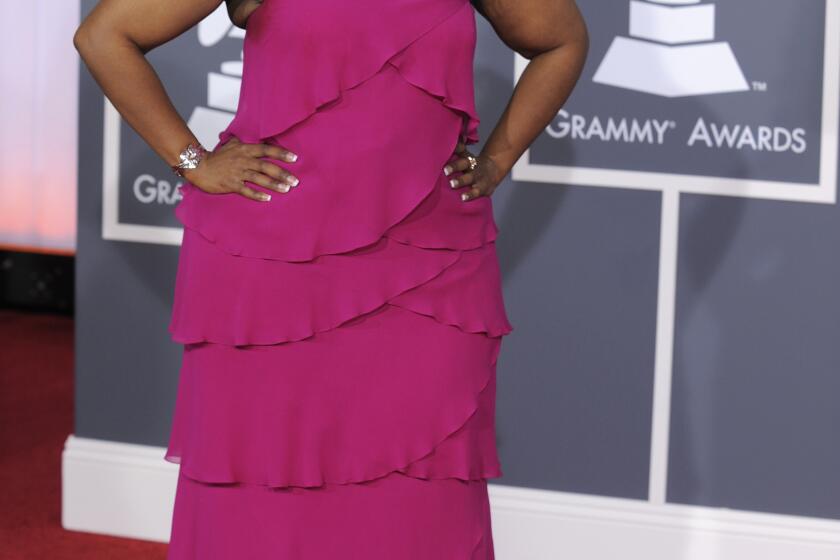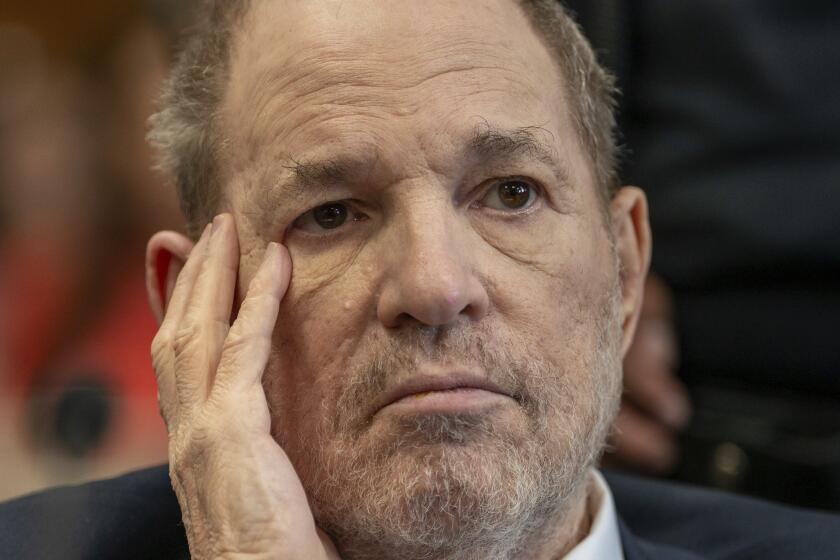Review: ‘Dodgers From Coast to Coast’ doesn’t get whole picture
At the outset, let it be noted that this book is for the faithful, those who bleed blue, who stay at the game until the last out (whatever the inning) and who don’t think the day is complete at home until Uncle Vinny signs off with a cheery “good-night everybody.”
“Dodgers From Coast to Coast: The Official Visual History of the Dodgers” is not an all-encompassing history, however, and the tone is far from objective. It has some wonderful bits of history and some glaring omissions. It is what it is, but that isn’t necessarily all bad.
This coffee table book — released just in time for Tuesday’s home opener marking the 50th anniversary of Dodger Stadium, is divided into nine chapters — you expected a different number in a baseball book? — and range from the early Brooklyn years to the Dodgers’ recent move of their spring training home from Vero Beach, Fla., to Arizona. There are two chapters on Brooklyn, including an essay by Roger Kahn (author of “The Boys of Summer”) and seven on the Dodgers in Los Angeles, mostly divided by decades.
The pictures are often surprising. Look on Page 22 and you see a trio of men in a mid-1950s photograph. Two of them are recognizable: The guy in the middle is Walter Alston, the Hall of Fame skipper of the Dodgers, and the guy on the left is a very young Vin Scully — the third man is Connie Desmond, another member of the Dodgers broadcast team.
Several of the great players in recent Dodgers history also offer their reminiscences. There is Mike Scioscia, the catcher and fortress at home plate who, after his career, became an exceptional manager for the Angels, remembering the life lessons taught by the great Roy Campanella. There is Tommy Davis, who won National League batting titles in 1962 and 1963, reflecting on the pitching, speed and defense that were the hallmarks of the team in the 1960s. There is Eric Karros writing about the meaning to him and his father of being drafted by the Dodgers. Wally Moon remembers the “Coliseum Years” when his ability to hit to the short field in left made him a fan favorite for his “Moon Shots.” And Wes Parker remembering his manager Alston. Shawn Green talks about his personal agony during Game 1 of the 1988 World Series, the Kirk Gibson game.
And there are some unexpected pleasures. Chapter 3, which records the Memorial Coliseum years from 1958 to 1961, has a section on a man named Danny Goodman, who was the team’s director of advertising and souvenirs. You like Dodgers bobblehead dolls? Thank Goodman. You recall fondly the replica baseball cap you got at the stadium years before merchandising of apparel became big moneymakers for major league teams? Thank Goodman.
The pictures recall the time when the Dodgers would fill the football stadium for baseball, and transistor radios were as vital as sunblock on a summer’s day. If you were on the 50-yard line for a baseball game, you needed to listen to Scully and his broadcast partner at the time Jerry Doggett, who handled most of the player interviews as well as the third and seventh innings of play-by-play. (Hard to image it now, but Scully once worked with a partner.) Skip into the section on the 1970s and you’ll find a history of the Dodger dog.
The design of the book is punctuated with covers of old baseball programs, including the one for Roy Campanella Night at the Coliseum in 1958 sold at a price of 20 cents. There is also a ticket stub from 1965 when Sandy Koufax threw a perfect game against the Cubs. Cost of a reserved seat ticket to that one was $2.50.
This is not an all-inclusive history, though, and some of the book seems oddly out of balance. There are sections on the usual suspects in Dodgers history: Branch Rickey (check), Jackie Robinson (check), Walter O’Malley (check), Koufax (check), Don Drysdale (check), Fernando Valenzuela (check), Mike Piazza (check), Tommy Lasorda (check), Hideo Nomo (check).
But what about Maury Wills? The man who stole a still-astonishing 104 bases in 1962, won the National League MVP award that year and was, without doubt, the most electrifying offensive player in the team’s early years in L.A. continues to get scant mention in the Dodgers narrative.
And, aside from what’s in the introduction, I found little on Scully and his overall importance to the team over the years. Perhaps there is the view that he is so much a part of us that we need no reminder. If so, that’s a shame and a dreadful oversight.
For the faithful, those who weathered the bad teams in the late 1960s, the now-23-year drought since the last World Series appearance, the trading of Mike Piazza, Scioscia’s sad departure for the Angels, and, of course, the McCourt years, this book will probably not be a disappointment.
But great books on the club in Los Angeles and on Scully — the linchpin who holds the history together from Brooklyn to Los Angeles — have yet to be written.
More to Read
The biggest entertainment stories
Get our big stories about Hollywood, film, television, music, arts, culture and more right in your inbox as soon as they publish.
You may occasionally receive promotional content from the Los Angeles Times.






